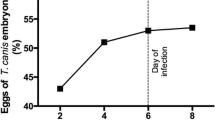Abstract
Recently, we have demonstrated the utility of Eimeria krijgsmanni as a novel mouse eimerian parasite for elucidating the biological diversity. The parasite showed notable infectivity to mice with various levels of immune status and susceptibility to antimicrobial agents including coccidiostat. However, the detailed lifecycle of E. krijgsmanni had not yet been determined and this information was lacking in discussion of previous findings. In the present study, we clarified the morphological characteristics of E. krijgsmanni and its lifecycle in normal mice, and examined the effects in immunodeficient mice and lifecycle stage for challenge infections after the primary inoculation. In immunocompetent mice, the lifecycle consisted of four asexual stages and the sexual sages followed by formation of oocysts during the prepatent periods. Interestingly, the second-generation meronts were detected in all observation periods after the disappearance of the other stages. For the challenge infection of immunodeficient mice, all developmental stages except for the second generation meronts were temporarily vanished. This finding suggests a “rest” or marked delay in development and a “restart” of the promotion toward the next generations. The second generation meronts may play an important role in the lifecycle of E. krijgsmanni.

Similar content being viewed by others
References
Carvalho FS, Wenceslau AA, Teixeira M, Matos Carneiro JA, Melo AD, Albuquerque GR (2011) Diagnosis of Eimeria species using traditional and molecular methods in field studies. Vet Parasitol 176:95–100
Daugschies A, Najdrowski M (2005) Eimeriosis in cattle: current understanding. J Vet Med Sci 52:417–427
Hashimoto K, Tanaka T, Matsubayashi M, Endo K, Umemiya-Shirafuji R, Matsui T, Matsuo T (2014) Host specificity and in vivo infectivities of the mouse coccidian parasites Eimeria krijgsmanni. Acta Parasitol 59:337–342
Heitlinger E, Spork S, Lucius R, Dieterich C (2014) The genome of Eimeria falciformis—reduction and specialization in a single host apicomplexan parasite. BMC Genomics 20:696
Inagaki-Ohara K, Dewi FN, Hisaeda H, Smith AL, Jimi F, Miyahira M, Abdel-Aleem AS, Horii Y, Nawa Y (2006) Intestinal intraepithelial lymphocytes sustain the epithelial barrier function against Eimeria vermiformis infection. Infect Immun 74:5292–5301
Lillehoj HS, Trout JM (1996) Avian gut-associated lymphoid tissues and intestinal immune responses to Eimeira parasites. Clin Microbiol Reviews 9:349–360
Linh BK, Hayashi T, Horii Y (2009) Eimeria vermiformis infection reduces goblet cells by multiplication in the crypt cells of the small intestine of C57BL/6 mice. Parasitol Res 104:789–794
McDougald LR, Reid WM (1997) Coccidiosis. In: Calnek BW (ed) Diseases of poultry, 10th edn. Iowa State University Press, IA pp, pp 865–883
Matsui T, Fujino T, Kobayashi F, Morita T, Imai S (2006) Life cycle of Eimeria krijgsmanni-like coccidium in the mouse (Mus musculus). J Vet Med Sci 68:331–336
Rose ME, Wakelin D, Hesketh P (1989) Gamma interferon controls Eimeria vermiformis primary infection in BALB/c mice. Infect Immun 57:1599–1603
Schmid M, Heitlinger E, Spork S, Mollenkopf HJ, Lucius R, Gupta N (2014) Eimeria falciformis infection of the mouse caecum identifies opposing roles of IFNγ-regulated host pathways for the parasite development. Mucosal Immun 7:969–982
Shi MQ, Huther S, Burkhardt E, Zahner H (2000) Immunity in rats against Eimeria separate: oocyst excretion, effects on endogenous stages and local tissue response after primary and challenge infections. Parasitol Res 86:891–898
Takeo T, Tanaka T, Matsubayashi M, Maede H, Kusakosako K, Matsui T, Mochizuki M, Matsuo T (2014a) Molecular and phylogenetic characterizations of an Eimeria krijgsmanni Yakimoff & Gouseff, 1938 (Apicomplexa: Eimeriidae) mouse intestinal protozoan parasite by partial 18S ribosomal RNA gene sequence analysis. Parasitol Int 63:627–630
Takeo T, Tanaka T, Matsubayashi M, Tsujio M, Umemiya-Shirafuji R, Tsuji N, Fujisaki K, Matsui T, Matsuo T (2014b) Evaluation of Eimeria krijgsmanni as a murine model for testing the efficacy of anti-parasitic agents. Acta Parasitol 60:190–195
Williams RB (1999) A compartmentalized model for the estimation of the cost of coccidiosis to the world’s chicken production industry. Internat J parasitol 29:1209–1229
Acknowledgments
This work was supported by the Japan Society for the Promotion of Science (JSPS) KAKENHI grant numbers 25292173 and 26660229.
Author information
Authors and Affiliations
Corresponding author
Rights and permissions
About this article
Cite this article
Ono, Y., Matsubayashi, M., Kawaguchi, H. et al. Course of induced infection by Eimeria krijgsmannni in immunocompetent and immunodeficient mice. Parasitol Res 115, 211–215 (2016). https://doi.org/10.1007/s00436-015-4737-z
Received:
Accepted:
Published:
Issue Date:
DOI: https://doi.org/10.1007/s00436-015-4737-z




